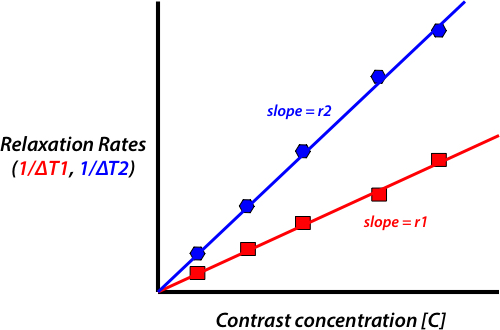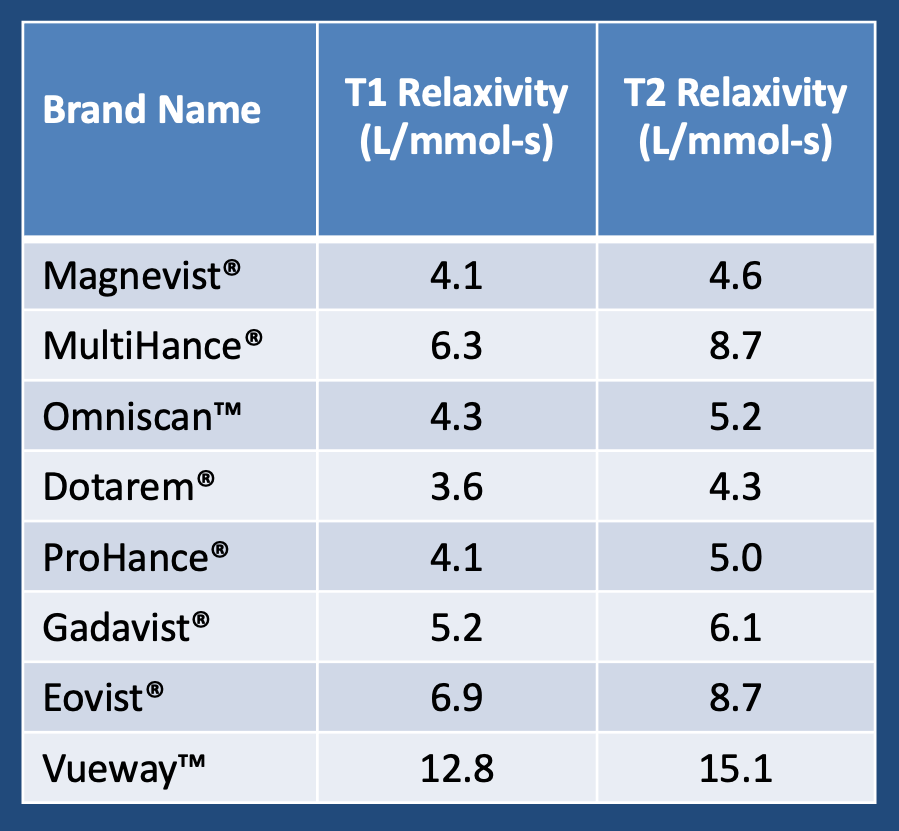The relaxivity of an MR contrast agent reflects how the relaxation rates of a solution change as a function of concentration [C]. Since a contrast agent may affect the two relaxation rates (1/T1 and 1/T2) individually, there are two corresponding relaxivities, denoted r1 and r2. By definition
1/ΔT1 = r1 • [C] and 1/ΔT2 = r2 • [C]
Since ΔT1 and ΔT2 are given in seconds and [C] is measured in millimoles per liter, r1 and r2 have units of L/mmol-s.
|
The relaxation rates of a contrast agent in solution are obtained by graphing changes in relaxation rates (1/ΔT1) and (1/ΔT2) at different concentrations. The slopes of the lines represent r1 and r2.
Relaxivity depends on the temperature, field strength, and substance in which the contrast agent is dissolved. For contrast agents in clinical use, it is typical to cite r1 and r2 values at 1.5T in plasma at body temperature (37°C).
|
|
The table left illustrates that all gadolinium contrast agents are not the same, showing considerable variability among r1 and r2 values. Agents with the larger relaxivities are those with higher molecular weights, higher protein bonding, or both. Excluding the liver agent Eovist®, MultiHance® has the highest T1 relaxivity of all the general extracellular agents, making it optimal for detecting enhancement on T1-weighted images at standard doses. MultiHance® also has high T2 relaxivity, meaning it also performs well as a susceptibility agent for perfusion studies.
|
Advanced Discussion (show/hide)»
The simple treatment of relaxivity provided here is referred to as the "fast exchange" model which assumes all protons that contribute to the MR signal have equal and unrestricted access to the paramagnetic center on a time scale less than or equal to the T1 relaxation time of the medium. Clearly this is not the case with biological tissues where multiple compartments exist with different exchange rates that may even be different in the forward and reverse directions. Nevertheless, the simple treatment here goes a long way to explaining basic phenomena involving contrast agent behavior in tissues and solutions.
References
Rohrer M, Bauer H, Mintorovitch J, et al. Comparison of magnetic properties of MRI contrast media solutions a different magnetic field strengths. Invest Radiol 2005; 40:715-724.
Rohrer M, Bauer H, Mintorovitch J, et al. Comparison of magnetic properties of MRI contrast media solutions a different magnetic field strengths. Invest Radiol 2005; 40:715-724.
Related Questions
Why does gadolinium apparently only shorten T1? Doesn't it have an effect on T2 as well?
What is the difference between relaxation rates and relaxation times?
Can the T2-shortening effects of gadolinium ever be observed on routine MR imaging?
Why does gadolinium apparently only shorten T1? Doesn't it have an effect on T2 as well?
What is the difference between relaxation rates and relaxation times?
Can the T2-shortening effects of gadolinium ever be observed on routine MR imaging?


